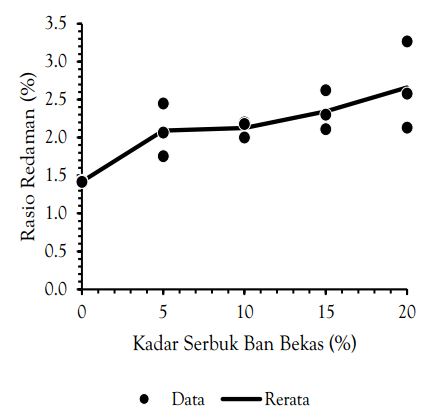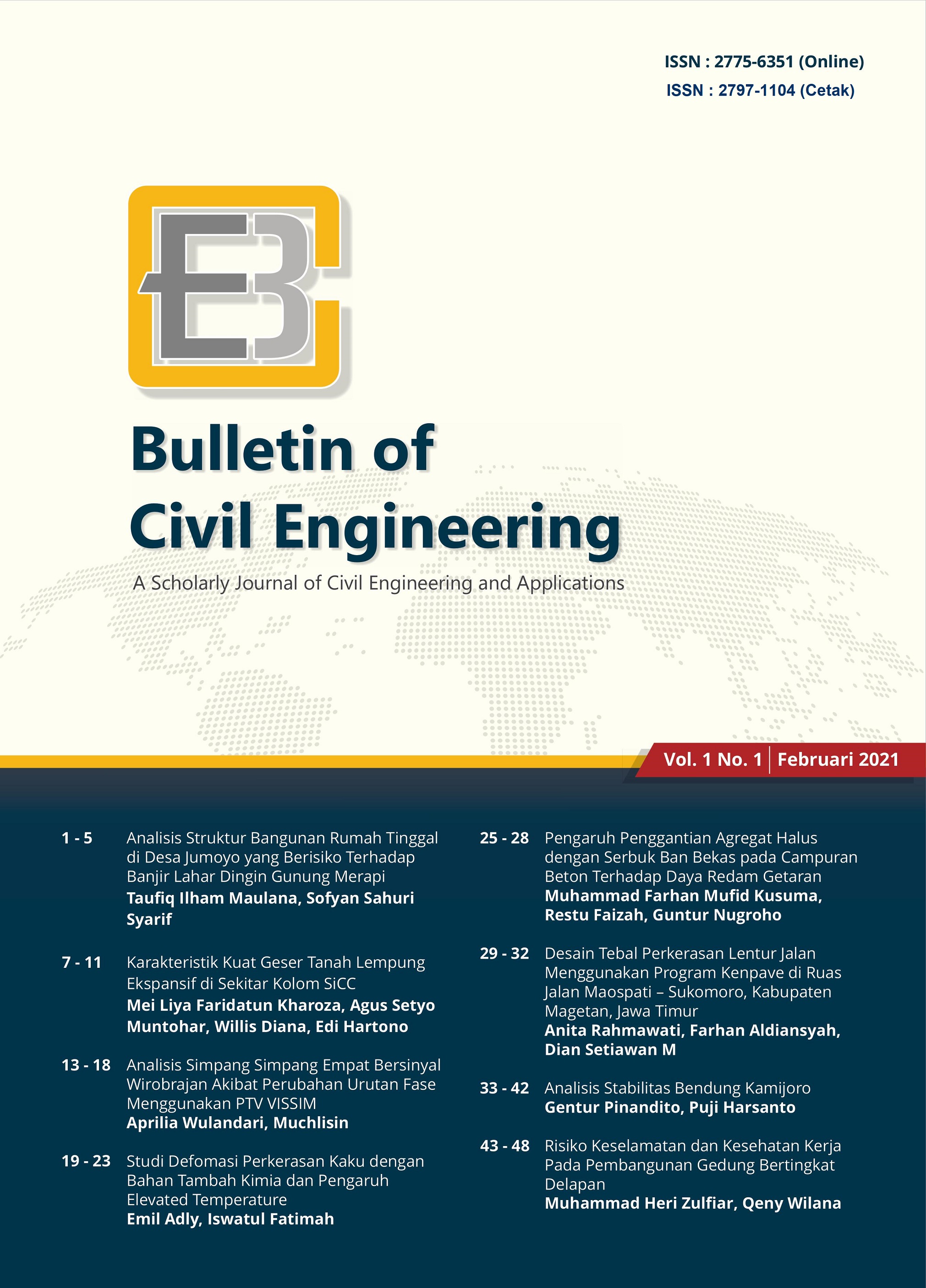Pengaruh Penggantian Agregat Halus dengan Serbuk Ban Bekas pada Campuran Beton Terhadap Daya Redam Getaran
DOI:
https://doi.org/10.18196/bce.v1i1.11051Keywords:
serbuk ban bekas, akselerometer, getaran, kuat tekan, daya redamAbstract
Limbah ban bekas merupakan salah satu limbah yang sulit untuk diatasi, karena karet ban sulit untuk di urai bahkan didaur ulang. Limbah ini, akan semakin meningkat seriring dengan bertambahnya produksi kendaraan di masyarakat. Salah satu upaya untuk mengolah limbah ban bekas adalah merubah ban bekas menjadi serbuk yang dapat dimanfaatkan untuk peredam gesekan di lapangan, merubah ban bekas menjadi minyak, bahkan merubahnya menjadi furniture. Inovasi dalam bidang teknik sipil ialah dengan mengganti agregat halus dengan ban bekas. Penggantian ini diharapkan dapat menciptakan beton ramah lingkungan. Metode yang digunakan adalah membuat benda uji berbentuk silinder dan balok, serta melakukan varian serbuk ban bekas dengan presentase 0%, 5%, 10%, 15%, 20%. Benda uji silinder digunakan untuk mengetahui kuat tekan yang dimiliki tiap varian presentase serbuk ban bekas, sedangkan benda uji balok digunakan untuk mengetahui daya redam pada masing-masing varian campuran. Pengujian kuat tekan beton dilakukan menggunakan mesin compression tester machine , dan pengujian daya redam beton menggunakan akselerometer getaran. Hasil dari pengujian dapat diketahui bahwa, semakin banyak presentase serbuk ban bekas yang digunakan, semakin menurun kuat tekan yang dimiliki beton. Sedangkan, untuk daya redam yang dimiliki, semakin banyak presentase campuran serbuk ban bekas maka semakin besar pula daya redam yang dimiliki. Hasil tersebut dapat menjadi sebuah tolak ukur untuk pengembangan beton ramah lingkungan, dan dapat menahan getaran lebih baik.
References
Faizah, R., Henricus, P., dan Akhmad, A., 2019, An Investigation on Mechanical Properties and Damping Behaviour of Hardened Mortar with Rubber Tire Crumbs (RTC), MATEC Web Conferences 258,05002 (2019).
Lee, K. S., Jeong-Il, C.., Se, E. P., Jae-Seung, H., dan Bang, Y. L., 2018, Damping Property Of Prepacked Concrete Incorporating Coarse Aggregates Coated With Polyurethane, Cement and Concrete Composites 93 (2018) 301–308.
Liang, C., Tiejun L., Jianzhuang, X., Dujian, Z., dan Qiuwei, Y., 2016, The Damping Property Of Recycled Aggregate Concrete, C. Liang et al., Construction and Building Materials 102 (2016) 834–842 835.
Putra, L. O., 2015, Perilaku Lentur Beton Yang Menggunakan Limbah Ban Sebagai Agregat, Fakultas Teknik. Universitas Hasanudin. Makassar.
Yuhesti, S., 2014, Kajian Eksperimental Penggunaan Limbah Biji Karet Sebagai Pengganti Agregat Kasar Pada Campuran Beton Ringan Kombinasi Pasir Tanjung Raja Dan Conplast Wp421, Jurnal Teknik Sipil dan Lingkungan. Vol.2. No.3.
Yung, H. W., Lin ,C. Y., Lee, dan H. H., 2013, A Study Of The Durability Properties Of Waste Tire Rubber Applied To Self-Compacting Concrete, Construction and Building Materials 41 (2013) 665–672.
Downloads
Published
Issue
Section
License
Copyright
The Authors submitting a manuscript do so on the understanding that if accepted for publication, copyright of the article shall be assigned to Bulletin of Civil Engineering (BCE). Copyright encompasses rights to reproduce and deliver the article in all form and media, including reprints, photographs, microfilms, and any other similar reproductions, as well as translations.
Authors should sign Copyright Transfer Agreement when they have approved the final proofs sent by the journal prior the publication. BCE strives to ensure that no errors occur in the articles that have been published, both data errors and statements in the article.
BCE keep the rights to articles that have been published and hold the copyright limited solely for the publication. Authors are permitted to disseminate published article by sharing the link of BCE website. Authors are allowed to use their works for any purposes deemed necessary without written permission from BCE with an acknowledgement of initial publication in this journal.
License
All articles published in BCE are licensed under a Creative Commons Attribution-ShareAlike 4.0 International (CC BY-SA) license. You are free to:
- Share — copy and redistribute the material in any medium or format
- Adapt — remix, transform, and build upon the material for any purpose, even commercially.
The licensor cannot revoke these freedoms as long as you follow the license terms. Under the following terms:
- Attribution — You must give appropriate credit, provide a link to the license, and indicate if changes were made. You may do so in any reasonable manner, but not in any way that suggests the licensor endorses you or your use.
- ShareAlike — If you remix, transform, or build upon the material, you must distribute your contributions under the same license as the original.
- No additional restrictions — You may not apply legal terms or technological measures that legally restrict others from doing anything the license permits.



